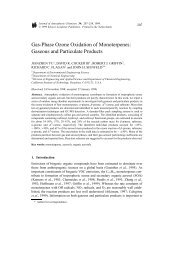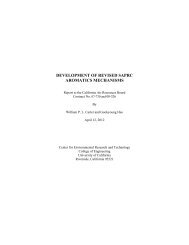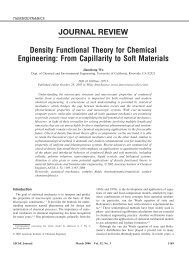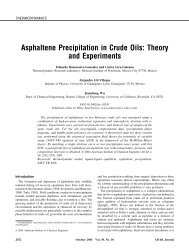Development of electroplated magnetic materials for MEMS
Development of electroplated magnetic materials for MEMS
Development of electroplated magnetic materials for MEMS
You also want an ePaper? Increase the reach of your titles
YUMPU automatically turns print PDFs into web optimized ePapers that Google loves.
ARTICLE IN PRESS<br />
192<br />
N.V. Myung et al. / Journal <strong>of</strong> Magnetism and Magnetic Materials 265 (2003) 189–198<br />
Fig. 2. Comparison <strong>of</strong> corrosion (polarization) resistances (R p )<br />
<strong>of</strong> iron group alloys in 0.5 M NaCl after 1 h immersion<br />
(Ref. [12]). Corrosion resistance is inversely proportional to<br />
the corrosion rate.<br />
deposits exhibited the greatest corrosion resistance,<br />
probably due to the smaller grain<br />
sizes. Similarly, the Co-rich HCP phase <strong>of</strong> CoNi<br />
alloys has lower corrosion resistance than the<br />
Ni-rich FCC phase. Nanocrystalline FCC<br />
70Ni30Co deposits exhibited the highest corrosion<br />
resistance among the CoNi alloys. The corrosion<br />
resistance <strong>of</strong> CoFe alloys are much lower than<br />
that <strong>for</strong> FCC NiFe and FCC CoNi alloys<br />
in chloride media. Substantial improvements<br />
in corrosion resistance are obtained by the<br />
addition <strong>of</strong> Ni to electrodeposited CoFe alloys.<br />
Conversely, the addition <strong>of</strong> B has only a slight<br />
effect on the corrosion resistance. We have<br />
determined the corrosion resistance <strong>of</strong> various<br />
alloys and Fig. 2 compares the obtained values <strong>for</strong><br />
iron group alloys after 1 h <strong>of</strong> immersion in 0.5 M<br />
NaCl [12].<br />
Electrodeposited films are more susceptible to<br />
corrosion than physical vapor deposited films or<br />
bulk alloys because the presence <strong>of</strong> organic<br />
additives (e.g. saccharin or thiourea) in the<br />
electrodeposition bath leads to the deposition <strong>of</strong><br />
a film that is anodically active, preventing the<br />
<strong>for</strong>mation <strong>of</strong> a passive film [16].<br />
2.1.3. Electrical resistivity <strong>of</strong> s<strong>of</strong>t <strong>magnetic</strong><br />
<strong>materials</strong><br />
A consequence <strong>of</strong> the drive <strong>for</strong> increasing data<br />
rates in data storage industry and <strong>for</strong> applications<br />
in RF <strong>MEMS</strong> is the requirement <strong>for</strong> faster<br />
switching <strong>of</strong> <strong>magnetic</strong> <strong>materials</strong>. Rapid <strong>magnetic</strong><br />
field switching results in the <strong>for</strong>mation <strong>of</strong> eddy<br />
currents, which can dramatically reduce the<br />
effective permeability <strong>of</strong> <strong>magnetic</strong> films during<br />
high frequency operation [7]. Two different<br />
approaches, the use <strong>of</strong> multilayered structures<br />
and increasing film resistance via impurity incorporation,<br />
were proposed to minimize eddy currents<br />
[7,11]. Yokoshima et al. [11] observed an<br />
increase in electrical resistivity from approximately<br />
20–130 mO cm with the addition <strong>of</strong> diethylenetriamine<br />
(DET) (up to 20 g/l) into the plating solution.<br />
This effect was attributed to carbon incorporation<br />
in the films, resulting in increased impurity-based<br />
electron scattering and a change in microstructure.<br />
However, increases in electrical resistivity via<br />
impurity incorporation can be detrimental by also<br />
decreasing the <strong>magnetic</strong> saturation <strong>of</strong> the material.<br />
Fig. 3 shows the electrical resistivity <strong>of</strong> electrodeposited<br />
NiFe and CoNi thin films and<br />
<strong>for</strong> comparison, the electrical resistivity <strong>of</strong> bulk<br />
CoNi alloys. It is seen that the electrical resistivity<br />
<strong>of</strong> electrodeposited NiFe alloys decreases<br />
Fig. 3. Electrical resistivity <strong>of</strong> NiFe and CoNi thin films<br />
electrodeposited from chloride baths and bulk CoNi (Ref. [12]).
















